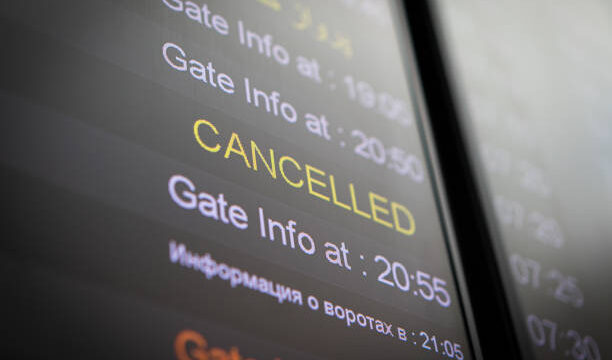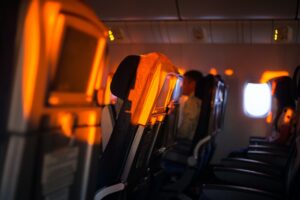
What Wind Speed Cancels Flights? Be Caution!
You’ve undoubtedly wondered whether wind speed delayed flights because of insane movies you’ve seen online or because of extreme weather on the day you travel. You could have been concerned about this as well, especially if you’ve never dug deeper into the underlying facts.
Table of Contents
Is flying safe in high winds?
The answer is, in general, yes. Aside from the fact that contemporary aircraft are intended to function well in high winds, pilots all over the globe must be able to demonstrate ability in flying in strong winds in order to obtain a license. Just as rain is practically never an impediment to safe flight, so are reasonably high winds.
Most (but not all) high winds allow planes to take off and land.
Of course, there are times when severe winds hinder takeoff or landing or cause bumps in flight—we’ll get to that in a moment. For the time being, let’s focus on what causes flight delays
What Wind Speed Delays Flights?
In reality, take-off and landing are the only occasions throughout a flight when high winds might cause delays; most flights experience high winds at some point during their rise or descent. With this in mind, horizontal winds (also known as “crosswinds”) over 30-35 kts (about 34-40 mph) are often restrictive of take-off and landing.
High wind speeds might force an aircraft to cancel its landing.
How this happens depends on where you are in the flight. If the plane is at the gate and there are significant crosswinds, air traffic controllers may simply postpone departure, as they would in heavy snow.
If the plane attempts to land in strong crosswinds (as you’ll see in a few paragraphs), the pilot may opt to abandon the landing, sometimes at the last minute!
Winds in the upper and lower levels
What wind speed slows aircraft at the ground differs greatly from what it does at higher levels of the atmosphere. In reality, high-altitude winds may dramatically reduce the length of a flight—at least when they blow from behind. Tailwinds are gusts of wind that occur as planes fly eastward, such as from the United States to Europe, and can last for more than an hour on long trips at certain times of year.
A breeze known as the jet stream may accelerate an aircraft at cruising altitude.
Headwinds, on the other hand, can cause a flight to take longer, which is why westbound flights (such as those from much of the US to East Asia) take longer than eastbound ones. Winds can also cause flight delays when they are accompanied by thunderstorms, even though they occur more frequently during ascent and descent than at cruising altitude.
Crosswinds Landing: Fact vs. Internet Fiction
Let’s return to the subject of crosswinds for a moment—the entire internet appears to be doing the same thing. Of course, while recent landings in Gibraltar and Amsterdam (among others) may appear frightening on film, pilots are taught to land in crosswinds—and to know when to give up and try again.
Crosswind landings are seldom disastrous.
To put it another way, while crosswinds make for fantastic viral videos (and maybe some churning passenger stomachs), they’re not terribly dangerous. Crosswinds, like turbulence, are almost likely not going to send your plane down.
What is the strength of the wind that passenger jets can fly in?
There is no one maximum wind restriction because it is affected by wind direction and flying phase. A crosswind of more than 40 mph with a tailwind of more than 10 mph might cause complications and prevent commercial planes from taking off and landing.
It is occasionally too windy to take off or land. The restrictions are in place to protect the passengers and personnel.
Maximum wind limitations for aircraft are classified as follows:
- The crosswind component is the wind’s side component.
- The amount of wind coming from the aircraft’s front.
- Tailwind – the amount of wind blowing from behind the airplane.
- Total wind – total wind speed
Aircraft prefer to take off and land with a headwind because it decreases the distance required to become airborne or to come to a stop. If an aircraft is stationary on the runway and has a 20kt headwind component, that is 20kts of air flowing over the wing, giving the aircraft an airspeed of 20kts even if it is not moving.If the aircraft has a take-off speed of 140kts, its ground speed only has to be 120kts to become airborne because it already has 20kts of velocity from the wind.
General Restrictions
At the aircraft certification stage, commercial aircraft must demonstrate the capacity to land with a specific crosswind. This exhibited limit is not a maximum restriction, but it is the amount that most operators (airlines) will choose to use as a limit – having an uncapped figure is not logical. As a result, the values supplied for the B737-800 below are typical of those set by an operator rather than the manufacturer.
Take-off Restrictions
A Boeing 737-800 has a maximum permitted crosswind component of roughly 33kts on a dry runway.It takes roughly 27kts to take off on a wet runway. The real amount may be somewhat higher or lower since the airline may opt to set its own more stringent value if it so desires. If the cross-wind component was bigger than this, the aircraft might be able to pick another runway that is more into the wind, but it would be unable to depart from a single runway airport.
Most commercial aircraft have no headwind limitations for take-off, hence there is no maximum overall restriction for take-off (or landing). In principle, if there was a 100mph wind, all of which was a headwind component, the airplane could take off.
However, there are wind restrictions for opening and shutting the airplane doors (about 45kts), and no pilot would taxi or depart in such conditions. In those conditions, the airport would have closed anyhow!
Heading vs. Tailwind
Typically, the highest permissible tailwind value is about 10-15kts. Tailwinds are easy to avoid at most airports since merely taking off in the other direction converts the headwind to a tailwind. A tailwind has the opposite effect of a headwind in that it increases the runway distance required for takeoff and landing.
However, owing of potential topographical concerns, it may be wiser to accept a tailwind on one runway rather than a headwind on another at some airfields. Florence is a fantastic illustration of this (FLR). Because of the extremely high hill/mountain in close vicinity to RWY05, it’s really preferable to take a little of a tailwind on runway 23 than a headwind on RWY 05. If you lose an engine, you must still be able to meet a climb gradient that will lift you over the terrain on RWY 05, which might mean you are highly weight constrained even with a headwind. Accepting a tailwind on RWY 23 might actually boost your maximum take-off weight.
Landing
On a dry runway, the crosswind limitation of the Boeing 737-800 is the same as during takeoff, 33kts. On a wet runway, this drops to a maximum speed of 30kts.
The maximum tailwind component for takeoff and landing is typically between 10-15kts, however the exact value that may be utilized may be significantly constrained by runway length, aircraft weight, and other factors.
In the case of a polluted runway, depending on the kind and depth of the contamination, both the maximum permitted crosswind and tailwind limitations are reduced. Most airlines prohibit tailwind takeoffs from polluted runways.
Taxi Capacity
Some planes have maximum taxi restrictions. The maximum taxi speed of a Boeing 737, for example, is 65kts.
Door Restrictions
The cargo and passenger doors can only be opened at certain times. It is not considered safe to open the doors if the wind speed exceeds 45kts.
Other factors that influence the maximum permitted wind speed include:
The airline may implement stricter regulations than the manufacturer. As a result, one airline flying a Boeing 737-800 may have different constraints than another.
Pilots have distinct restrictions. Captains can often operate the aircraft up to the maximum authorized limitations, however Senior and Junior First Officers have more stringent restrictions. If the landing surpasses their capabilities, the Captain will perform it.
Wind limitations are restricted at several airports. For example, the maximum cross wind restriction at London City Airport is 25kts, yet some of the aircraft flying into it have a dry runway limit of 38kts for take-off and landing. This is due to the fact that it is narrower and shorter than other airports.
Design of an aircraft. A crosswind will affect an airplane with a large vertical stabilizer (the large fin at the tail) more than one with a tiny one. Crosswind is also more likely to affect an aircraft with winglets.
Conclusion
Relax, whether you’re inquisitive about the practical implications of whether windspeed delayed flights or you’ve sought from a more paranoid perspective. While severe winds might occasionally impede planes from taking off or landing on time, they will not jeopardize your travel. Indeed, the little delays caused by heavy winds are the reason why, despite their apparent danger, flying in high winds is totally safe! Below, use Skyscanner to find (hopefully!) on-time flights.


